More and more residents of large megacities are today striving to leave ...
|
|
The foundation is the basis of the house. It depends on him how durable it will be ... |
Today, many people are interested in the possibility of independent houses. Why... |
How to dock laminate and tiles
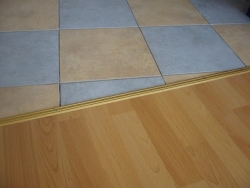
Designers nowadays offer to use combined flooring in one room (hallway, living room, kitchen). The combination of a laminated board and ceramic tiles makes it possible to zone the room and this optically increases it. At the same time, it is customary to lay the tile on more contaminated areas of the floor, and the laminate is less contaminated. Let's figure out how to combine laminate and tiles within the framework of one room today.
Content:
- Joint use of laminate and tiles
- Foundation processing options
- Features of the connection of tiles and laminate
Joint use of laminate and tiles
Modern floor coverings have their own characteristics, therefore are suitable for a particular functional zone or room, because they perform their functions. Rarely, after all, you will meet the same floors throughout the apartment! Natural stone and parquet are responsible for the presentability of rooms such as an office or living room. The tile in the kitchen is responsible for hygiene and wear resistance due to the fact that it is easier to keep it clean than, for example, carpet, which, like cork coatings, is often located in the children's room, protecting children from various injuries during falls.
Therefore, in the houses, quite often various combinations of flooring began to occur. Most often in one room you can see tiles and laminate, which are laid for its division into zones. And all this is explained by the fact that ceramic tiles acts as a rather stable material to all sorts of external influences, but expensive.
But the laminate is characterized by a low price, but at the same time its qualities are not the highest compared to ceramics. The main problem of the laminate is that it is not so simple as ceramic tiles, that is, it is afraid of moisture. However, by combining two such material, you can get a durable, practical, rather strong flooring, which will please you with its price. In this case, the question arises of how to combine a laminate with tiles, and what to do with the resulting joint.
First of all, you need to talk about the features of the joints themselves and their design. Perhaps the main thing to remember is that they should not spoil the aesthetic appearance, and I would also not want to stumble about them. The threshold itself must perform strengthening and decorative functions. The correct design of the joints of the tiles and laminate will significantly help extend the life of flooring.
The need for simultaneous laying of laminate and tiles often occurs in the kitchen-dining room. In this case, the docking of the laminate and tiles on the table of the dining room is carried out in a natural way. In the kitchen working area, which is quickly polluted and characterized by high humidity, they advise laying ceramic tiles on the floor. Such zoning can be carried out using catwalks (small elevations). It is much more difficult to perform the transition of laminate coating to tiles at the same level.
The combination of various flooring also justifies itself in the corridor and hallway. It is obvious that the tile is better washed, more resistant to abrasion and, accordingly, is not very afraid of sharp heels. A practical and reasonable solution will be the flooring of ceramics in the hallway, which goes into the laminate coating of the corridor and leads to the living area.
Sufficient experience of combining materials of different properties, such as tiles and laminate, makes it possible to get a common win in the practicality of use, strength and life of the floor covering in the living room. Near the exit to the balcony and the fireplace in the living room, ceramic tiles are laid, and in other parts - laminate.
The combination of laminate and tiles can be made using a conventional cut of the joint of such coatings along the border and shape with fastening to the base or black floor, through the use of prefabricated structures with the presence of special mounts and nozzles. The use of each method as a whole will determine the external attractiveness of the floor, the overall impression created by the flooring, as well as the time of the service of such a composition without the need for repair.
Foundation processing options
When laying a laminate and tiles, only one question will appear - how best of these two finishing material to join each other. At the present time, there are a large number of options for combining ceramic tiles and laminate boards. Beauty, visual integrity and the service life of the flooring depend on the chosen type of mockery.
Porogs or molding
The single -level joints between the laminate and tiles are often made with rapids, thresholds or moldings. The material for the manufacture of rocks is ordinary aluminum, wood or various types of plastics. Of course, from the point of view of strength and resistance to abrasion, aluminum leads here. But its application does not always fit into the design solution of the flooring.
Porogs are ideal in cases where two floor materials are unevenly jointed or they are placed at different heights. You can also attribute to the advantage of plastic rocks that you can choose it in color to ceramic tiles or laminate board. Porogs will hide all the shortcomings and make the transition from laminate to tiles neat and smooth. And the most interesting thing is that such a docking option is the simplest.
Most often, rapids are straight, but sometimes there are curved shape. Remember when choosing a spin that straight simple models are suitable for rooms where the transition from laminate to the tile is straight. If the transition of the corner, semicircular or completely different geometric shapes, it is necessary to purchase special rapids that take any shape, that is, they can bend. Such a threshold is called a flexible or curved profile.
It is made of plastic, but its base is rubber. Aluminum and plastic profiles are bending, and do not bend wooden profiles, so they require an almost even laminate and tile connection. It is more reliable and easier to attach them to the surface of the black floor on self -tapping screws or dowels. Of course, at the same time you can seek that the threshold is located at the same level with coatings on both sides.
All thresholds are prefabricated, which consist of a removable lining and mounting, and whole, which are attached on an adhesive base or directly to the base of the floor. You can also highlight the hidden type of fastening (the mount is hidden under the decorating bar) and open (fasteners are visible). In this case, the rapids perform the function of protecting the edges of floor materials that can begin to exfoliate without them, and constantly dirt will accumulate in the cracks.
Fastening without breasts
Along with the above technique of docking the laminate and tiles, it is used widely laying the coatings of VSTOK without any additional materials. This method of connection without transitional elements and additional materials requires accurate performance. On the draft field, the fastening of coatings should be the same level and are made in compliance with all the rules of fasteners, especially in the places of their joint.
In advance, it is necessary to measure and cut the joint using pre -prepared templates. Such a rule is always observed for a complex shape of the border of the two zones. The resulting seam must be thoroughly wiped. No threshold will help to arrange a curved joint.
Construction foam and sealant
Another option, how to dock laminate and tiles, is the use of silicone sealants, mastic and construction Pen. They make it possible to hide the joint between the laminated board and the tiles of any shape, depth and width. In order for the joint to look more beautiful, you can choose a silicone in color to ceramic tiles or laminate. This technique of execution, unfortunately, does not provide for partial or mobile repair of parts of the floor. If necessary, you will have to dismantle the entire joint.
It can be considered another disadvantage of using construction foam or sealant - the need for the corresponding experience with such materials due to the fact that it is difficult to remove an excessive amount of material from the surface of the coating, and its deficiency does not give a reliable attachment of the joint. The most important thing when working with such materials is not to overdo it, that is, not to squeeze an excessive amount of silicone, sealant or foam.
Cork compensator
The cork compensator is considered the best option for decorating gaps, which are formed between tiles and laminate. This material looks very neat and beautiful and effectively provides a combination on one surface of ceramics and laminated coating. A single disadvantage of the cork compensator is that he cannot hide even a slight uneven joint. For a collection of ceramic tiles and a laminated board, a cork compensator needs to work with them very well. It is necessary that the joint is perfectly even both in depth and in width.
Features of the connection of tiles and laminate
Before joining the laminate and tiles, it is necessary to represent the final result. It is important to understand that the service life of such gender will depend on the quality of the work of the combustion. In general, if we consider the entire sequence of work, you should build on the available material and your chosen method of docking.
Direct joint
Preparation of the catwalk or a unresting step is required that your coating is a single floor level. For this, the same option will be the same thickness of the laminate and ceramics. Planning the junction itself, it is better that it is located in the center of the arched or doorway. Such a joint will also look quite organically in the central part of your room. The width of the clearance, which is formed between the coatings, should be no more than 5 millimeters.
The best and more simple way of connecting the laminate and tiles is the threshold, both according to the mounting method and the possibilities of hiding a small difference in heights and the small irregularities of the obtained sections of the floor. For even sections of joints, quite direct mounts are suitable. And for more curved complex forms of docking, special thresholds are used. For example, with the possibility of bending to give the necessary form and a perforated base.
Certain types of thresholds already have fasteners in the center of the surface, and some are designed for secret fastening, that is, by snapping on a several protruding and flat head of the screw. And all this suggests that it is necessary to first choose the mounting elements that correspond to the type of rock.
The rapids are very simple if you follow some rules:
- Tiles and laminate must be laid out at the same level (this has already been talked about);
- Without fail, it is necessary to leave a deformation gap between them;
- In this deformation gap is installed by an aluminum threshold.
Wave -shaped joint
In which cases will require a wave of wave -like shape, it will be a little more difficult to arrange it than a straightforward one. With a wave -like junction, tiles and laminate are laid, as usual, it is necessary that the laminate slightly overlap the tile. After tile glue has dried, we begin to create a cardboard pattern of wave -shaped connection.
By applying to the laminate, which lies over the tile, the template is marked on the laminate directly along the template line. Next, we cut off the desired circuit with a jigsaw. Using a pencil, we carry out the transfer of the laminate cut line to the tile. We disassemble part of the laminate, after which we saw the tile along the drawn line. For such purposes, we use a grinder that has a diamond circle.
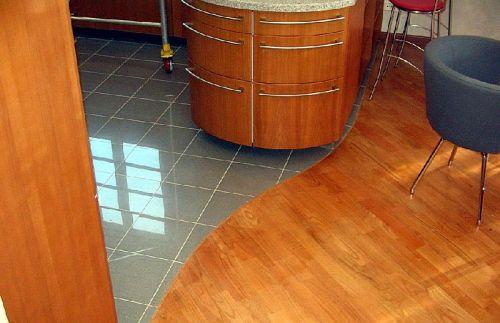
From tiles for ten centimeters, removing the substrate, proceed to laying the laminate. In places where the substrate was removed, the laminate must be glued to the primed screed, which will give it additional strength. The usual silicone is used as glue, while carefully monitoring that the excess does not leave the seam. The right amount of silicone is determined depending on the height of the tile.
And finally, the resulting seam should be wiped and make sure that the laminate does not walk in the joints. Only on condition that the seam will turn out to be strong and high -quality, such a floor combined coating will serve for many years. If, nevertheless, the connection between the tiles and the laminate is not durable, and the laminated board is poorly attached, it is also necessary to add silicone selected in color to the seam.

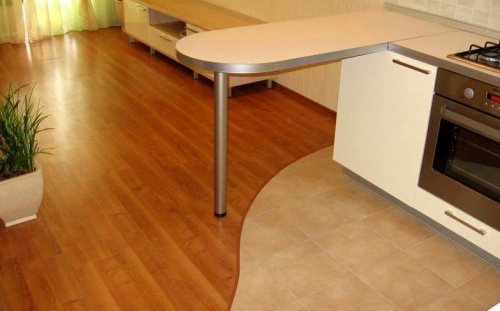
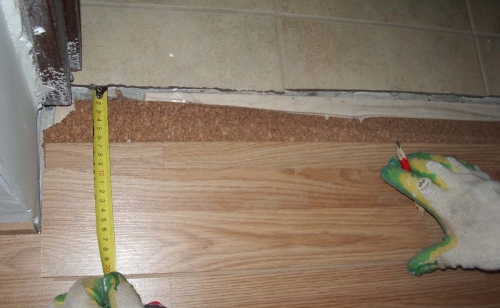
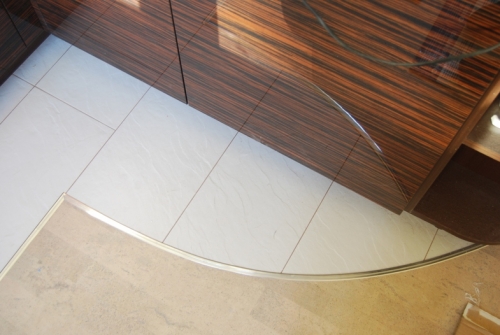
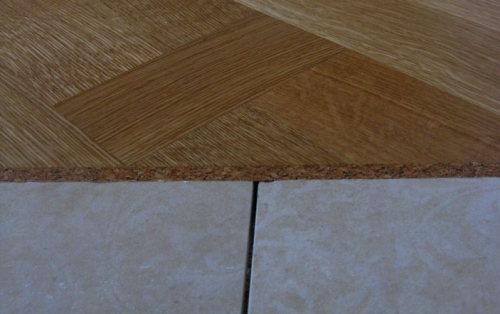
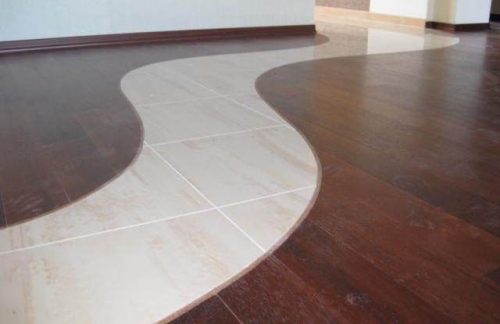
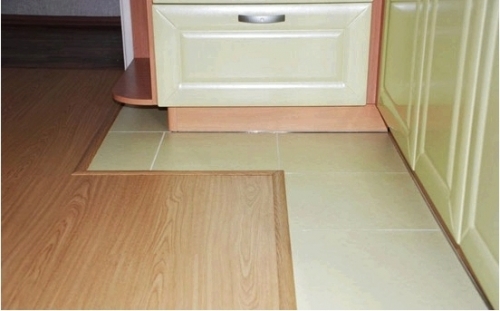
Where I can buy flexible
Where I can buy a flexible cork connector
How can I order a connector
How can I order a connector from you?
There are also cork
There are also cork compensators covered with varnish. They are better suited for docking tiles with a parquet board or laminate or other material that is already covered with varnish or oil (you do not have to open the cork separately)
Camping compensators in Russia: http://probkaru.com
Cork compensators in Ukraine: http://probka.kiev.ua